

 The South African
The South African
Major Darrell D. Hall
Major Hall has written a number of articles on guns which have been published in the Military History Journal — ‘Guns in South Africa 1899-1902’, (Vol. 2, Nos 1, 2 and 3), and ‘Field Artillery in the British Army 1860-1960’ (Vol. 2, Nos 4, 5 and 6). The following article is the first of a series on artillery ammunition.
The 15 pr 7 cwt BL was the standard field gun of the British Army during the Boer War of 1899 to 1902. Consequently there were more 15 prs (about 300) in service in South Africa during the war, than any other gun.
It is important that a student of the military history of this period should have some idea of the 15 pr’s ammunition, as its performance was a significant factor in the outcome of every battle of the war.
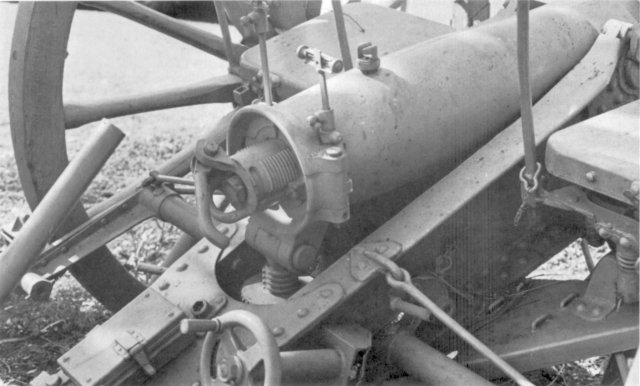
There is another important reason for studying the ammunition of any gun. It is not the gun which causes casualties, but the shell. The organization, training and equipment of an artillery unit have but one aim — to place shells on an enemy position in such a way as to cause the maximum casualties and damage to the
enemy. The 15 pr’s main shell was shrapnel; but there was also case shot, for use at very short range against targets such as enemy infantry. The functioning of the 15 pr shell is described in this article. An explanation is also given of the method of firing the gun.
The article consists of the following parts:
1. T-friction tube.
2. Cartridge, BL, 15 pr.
3. Fuze, time and percussion, No 56.
4. Shell, BL, shrapnel, 15 pr.
5. Shot, BL, case, 15 pr.
In nearly all cases, the 15 prs in service in South Africa were fitted with the Mark I gun. In this context, the term ‘gun’ refers to the barrel from muzzle to breech screw. The gun was mounted on a carriage, but the carriage is not relevant to this article, so no further mention will be made of it.
The 15 pr was a breech loading equipment. To load, the breech screw was opened, a shell and cartridge inserted, and the breech screw closed.
To fire the gun, it was necessary to cause a flash to be passed into the chamber in order to ignite the cartridge, and so propel the shell from the gun. In the case of the 15 pr Mk I gun, this came from a friction tube.
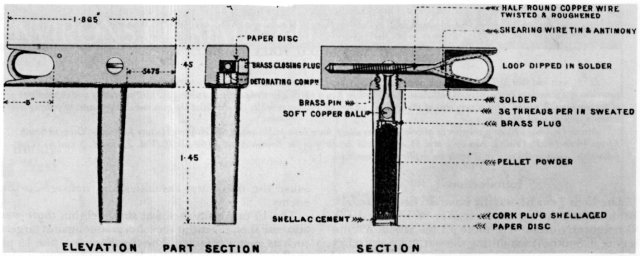
As the name implies, the T-friction tube was shaped like a T, with the head of the T and its stem both being about 4,8 cm (1,9 inches) in length.
After loading the gun, the T-friction tube was placed in the T-vent. This was a hole in the upper surface of the gun just forward of the breech screw. A locking device secured the tube in this vent. A lanyard was attached to a loop in the head of the T.
On the order to fire, the loop was pulled, drawing the friction wire sharply out of its socket. The resulting flash passed vertically downwards, so igniting the pellet powder, which in turn flashed into the chamber.
Gases trying to escape upwards drove the soft copper ball into the cone seating, thus preventing the escape of gas through the head and, by expanding the body of the stem, also preventing any escape of gas between it and the vent. The flash ignited the cartridge.
The T—friction tube was then removed and discarded. As one was used for every round fired, a pile of friction tubes would build up next to each gun. The discovery of old friction tubes therefore provides conclusive evidence of the location of a gun position.
T—friction tubes were packed ten to a square tin box. These were also discarded when empty. The remains of these can sometimes be found on old gun positions.
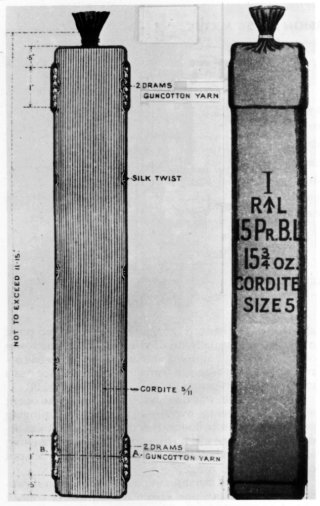
The cartridge was loaded into the chamber of the gun, behind the shell. On ignition, it exploded and propelled the shell from the barrel.
The 15 pr cartridge was composed of cordite and was contained in a cloth bag. Cordite was a mixture of nitrocellulose, nitroglycerine and mineral jelly, gelatinized by acetone. It was pressed into cords - hence the name 'cordite’. It was adopted for use by the Services in 1891 in place of gun powder.
As described in Part 1, the T—friction tube sent a flash down the vent to ignite the cartridge. With the cordite enclosed in a cloth bag, an igniter of some sort was required. For this purpose, guncotton yarn was wound round the base of the cartridge. This was ignited by the flash, and it then caused the explosion of the cordite.
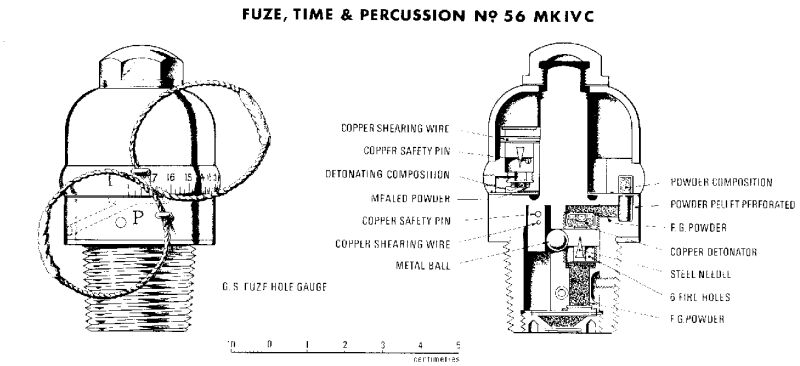
The functioning of the fuze preceded that of the shell, so the fuze will be described first.
The 15 pr shell’s fuze was a ‘nitric acid percussion’ type. This meant it could be set either to go off in the air (when the effect was known as ‘time shrapnel’), or on impact with the ground (known as ‘percussion shrapnel’). As shrapnel was most efficient when exploded in the air, the nitric aspect was the most important. Unfortunately the fuze’s time scale was shorter than the shell’s time of flight at maximum range. This meant that the fuze could be set to burst at ranges up to 3 750m (4100 yds), but from there to 5 120m (5600 yds), it could only explode the shell on impact. This drawback severely curtailed the effectiveness of the 15 pr, and it frequently required the gun to be brought forward under fire to within time shrapnel range of 3750m (4 100 yds).
In order to set the fuze, the nut at the top was loosened, using the Universal Fuze Key, or the socket provided on the trail of the gun. The graduated ring was moved to the fuze length ordered, and the nut retightened. Both safety pins were then removed, the shell loaded and fired.
The shock of firing caused ‘set-back’. i.e., the effect, of ‘leaving moving parts behind', as the shell suddenly set off up the barrel.
The removal of the upper safety pin freed the steel needle on the left of the diagram. Set-back caused the needle to be driven into the detonating composition. The mealed powder then started burning round the time ring, the fuzee setting controlling the amount which actually had to burn. On completion of this action, a powder pellet was detonated, and the resulting flash passed downwards through various channels into the body of the shell.
Earlier it was mentioned that both safety-pins were removed. This was to ensure that the percussion mechanism of the fuze would operate on impact, if the time mechanism malfunctioned. If the shell were specifically required to burst on impact as percussion shrapnel, the upper time safety pin was left in, and only the lower percussion safety pin was removed. It was necessary to leave the upper safety pin, as otherwise the time fuze action would automatically start when the gun was fired.
The removal of the lower safety pin released a metal plug. On set-back, this plug moved to the bottom of its shaft. Centrifugal force, caused by the rotation of the shell, then threw the metal ball outwards in to this shaft. The removal of this ball then freed the steel needle alongside it. On impact, this was driven into the upper detonator and, as before, the resulting flash passed downwards into the shell.
Later in the war, a new fuze, No. 57, was introduced. This was known as the ‘blue fuze’ from the colour it was painted. It had a slower burning composition effective up to 5 313m (5 800 yds).
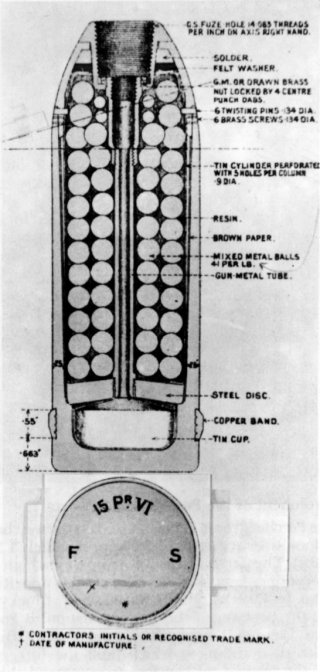
In 1784, Lieutenant Henry Shrapnel of the Royal Artillery invented a ‘spherical case shot’. This was a circular projectile, filled with musket balls or the equivalent, and detonated by a time fire. It was first used in battle in 1804, against the Dutch at the Battle of Fort Amsterdam, Surinam, in South America. In 1852, ten years after the death of the inventor, orders were given that such shells were to be called ‘shrapnel shells’ in his honour.
Improvements in gunnery led to changes in shell design, and the shape changed to that well-known today. In its new form, shrapnel remained in service until and including World War I.
Not all guns in 1899 fired shrapnel. The 5 inch (12,7cm), howitzer for example, fired common shell. This was filled with lyddite and burst on impact. Lyddite was followed by TNT, and shells became known as high explosive, or HE. The improved fragmentation effect of these HE shells made them more effective than shrapnel which slowly disappeared from the scene. Like shrapnel, they could also be burst in the air or on the ground. Strictly speaking, references to ‘shrapnel’ today should be references to ‘shell fragments’ instead.
There was a copper driving band round the outside of the base of the 15 pr shrapnel shell. This was forced into the rifling grooves in the barrel of the gun on firing, giving the shell its rotating movement. The shell was filled with metal bullets - 41 to the lb (0.45 kg), 200 in all, packed in resin. The fuze was screwed into a threaded fuze hole in the nose. Brass screws held this nose-cap in position. On detonation, it was blown off.
After the fuze acted as described in Part 3, the flash passed down the centre of the shell to the bursting charge in the tin cup at the base. This exploded, driving forward the steel disc and shearing the nose-cap off the shell to allow the shrapnel bullets to be thrown forward on to the target.
The resin was ignited by this explosion, and gave a puff of white smoke at the point of burst. This was useful for the Battery Commander observing the fire, enabling him to give the necessary corrections.
The bursting charge which achieved this, consisted of 1½ oz (42,5 g) of RFG (rifle fine-grained powder).
It was obviously important to burst the shell at the correct distance short of the target, and at the correct height above the ground. On bursting, the shrapnel bullets were thrown forward along the line of the trajectory of the shell, in a conical shower. The greater the distance that the shell burst short of the target, the greater was the dispersion of shrapnel bullets. The rough rule was that the spread of bullets was one fifth of the distance short of the target, i.e., the spread at 45m (50 yds) was 9m (10 yds), at 180m (200 yds) it was 36m (40 yds).
The amount of dispersion also depended on the velocity of the shell at burst. As this velocity decreased with range, the velocity of rotation of the shell had more effect — and the cone of dispersion was greater.
The striking velocity of the bullets also fell off as range increased — so at long distances it was necessary to burst the shell closer to the target than at short distances. For example, up to 900m (1 010 yds), the burst could be 80m (90 yds) short; up to 1 800m (2 000 yds), 63m (70 yds) short; up to 2 700m (3 000 yds), 45m (50 yds) short; and up to 3 600m (4 000 yds), 36m (40 yds) short.
It was impossible to judge at the gun position how far a shell bursting in the air was short of the target. However, as height of burst could be judged, it was possible to make a rule to cope with this problem. This stated that the height of burst in feet should be two-thirds of the range in hundreds of yards. In other words, 5m at 2 195m (l6ft at 2 400 yds); and 8m at 3 565m (26ft at 3 900 yds).
This was the theory. The nature of the ground, the type and size of the target, the weather conditions, etc, all affected the issue. The actual fuze length and point of burst were usually decided by ranging, which was observed by the Battery Commander. He ordered corrections until he was satisfied, and his experience was a most important factor.
Time shrapnel was used against troops in the open; where there was no overhead cover; or as a ranging projectile against balloons. Percussion shrapnel was ordered when there was no time to set fuzes; for ranging; against troops in buildings or behind walls, or when out of time shrapnel range.
When the shell burst on impact as percussion shrapnel, it still had a shrapnel effect. After graze, or contact with the ground, the shell had an ascending angle, but the velocity was considerabl decreased by the impact. It was, therefore, necessary to land the shell very close to the foot of the target, otherwise the cone of shrapnel bullets passed over the top and landed in a shower some 229m (250 yds) further on.
To be at all effective against a house or a wall, the round had to be landed close up against the wall. But, in practice, percussion shrapnel was not very successful. If the ground were soft, the shell would bury itself, and the explosion of the bursting charge would produce nothing more than a mangled shell casing and a negligible lethal effect. Where possible, 15 prs were brought unto action within time shrapnel range.
Fragments of shell casing picked up on South African battlefields are normally from common shell fired from such guns as 5 inch (12,7 cm) howitzers, 5 inch (12,7 cm) guns, etc. In the case of common shells, the lethal effect was caused by the fragments of shell casing thrown out violently on the explosion of the shell. No shrapnel bullets were involved.
No doubt by now all 15 pr shell casings have been picked up. These would normally have been intact except for the nose-caps. There should still be a number of shrapnel bullets lying about. Unfortunately for the souvenir hunter, most will now be covered by earth or vegetation and will be difficult to find. The enthusiast may find pieces of the tin cylinder which enclosed the shrapnel bullets in the shell. This was perforated with holes 2,28 cm (0,9 inches) in diameter.
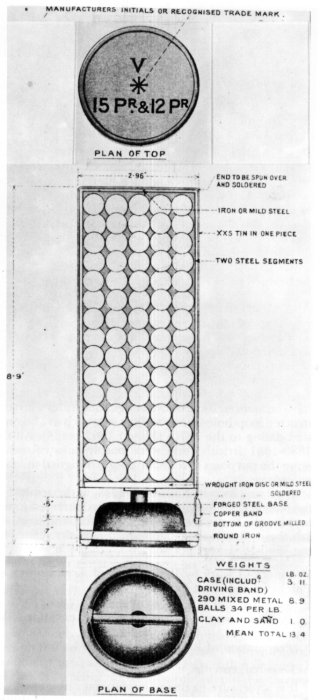
This projectile was used in emergencies to prevent guns being overrun. It was like a shot-gun cartridge. It consisted simply of a flat-topped cylinder, filled with 290 metal bullets with a bursting charge at the base.
Case shot was loaded and fired in the same way as shrapnel. It broke up at the muzzle and the bullets had a considerable spread. It was used at close range against troops, and was effective up to 275m to 365m (300 to 400 yds). The lateral spread was 14,23 and 37 metres at 90, 180 and 275 metres (15,25 and 40 yds at 100, 200 and 300 yds).
The great advantage of case was that, it required no preparation, and its large number of bullets was spread very widely. If all case were expended, shrapnel could be used set at Fuze 0. (With muzzle loading guns in such emergencies, shrapnel was loaded reversed, without fuze or plug.)
Two instances were recorded of case shot being used in the war. Two guns of Q Battery RHA, used case at Zilikat’s Nek on 11th July, 1900; and two guns of 75th Battery, RFA used case in a gallant defence at Buffelspoort on 3rd December, 1900, when a British convoy was overrun.
Ammunition holdings per gun in an RFA battery were as follows:
| On the gun | 2 case |
| 2 shrapnel | |
| In the limber | 48 |
| In the ammunition wagon | 96 |
| 148 | |
There are many reports of the effectiveness of 15 pr shrapnel during the Boer War. Some said that the most effective guns the Boers had were the 15 prs they captured from the British.
The shell had its limitations, mainly because of the short burning time fuze. It was not fully effective as a shrapnel shell until the ‘blue fuze’ No. 57 was introduced. Oddly enough, the shell did not weigh 15 lb. (6,8 kg). Its weight was 14 lb (6.35 kg) (or 14 lb 1 oz (6,38 kg) according to some sources).
At the beginning of the war, British gunners found themselves outranged by many of the more up-to-date Boer guns. Until the arrival of the new fuze, much depended on their coolness as, time after time, they coolly trotted forward under fire, until they were within time shrapnel range. It was this coolness, coupled with the concentration of artillery support wherever possible, which did much to enable this disadvantage to be overcome.
Finally the importance of the 15 pr’s shell in the Boer War can be gauged by these figures. Excluding the pom-pom, 233 714 shells were fired by British guns during the war. Of these, 166 548 were 15 pr shells.
Reference: Treatise on Ammunition (HMSO London 1911).
Return to Journal Index OR Society's Home page
South African Military History Society / scribe@samilitaryhistory.org